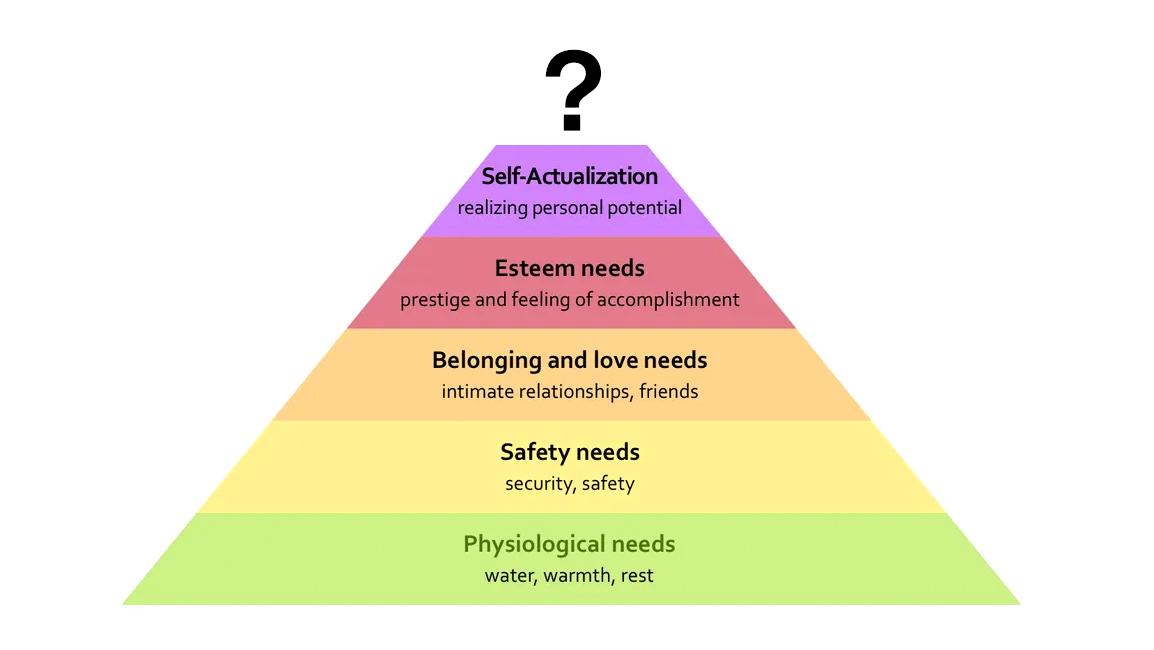Maslow’s Hierarchy of Needs has served as the foundation for understanding human motivation since it was first published in 1943 as part of “A Theory of Human Motivation” in Psychological Review. The hierarchy, visualized in pyramid form, is often given as an introduction to human psychology and still holds weight in population conversation about what humans need from life, and in what order they need it.
But Maslow’s hierarchy as we commonly know it is incomplete, says Nichol Bradford. Later in his life, after the hierarchy had been published, Maslow began work on a final stage of human motivation. Self-actualization was not the pinnacle of individual human achievement, but rather self-transcendence. Not an elevation of the self, but a subverting of it.
This takes us to different perspectives on human psychology itself. Achieving self-actualization means resting comfortably inside the boundaries of human psychology — accomplishing what is knowable and testable — while self-transcendence means pushing beyond them. Whether through spiritual meditation, self-denial, or more recently through technological means, challenging the definition of consciousness to expand into new areas of knowledge — beyond self-knowledge — may be the ultimate stage of human development.
One technological path toward self-transcendence is the singularity, an event in which human biology and computers become one. Integrating hardware and software into the flesh and mind of our bodies represents an opportunity to literally overcome our present physical limitations. While this may yet prove a promising endeavor, Bradford says human problems still have human solutions. Overcoming the narrow confines of the self may be as simple as giving yourself over to others: their dreams, their goals, their passions. And by doing so, you become one with them.
Nichol Bradford is the author of The Sisterhood.
Nichol Bradford: Many people think that Maslow’s hierarchy of needs stopped with self-actualization. And that’s not actually true. He had another piece that was on top of self-actualization and that was self-transcendence. He just didn’t publish it widely before he passed away. It was something he started working on towards the end and so he published the hierarchy of needs before he finished his work on self-transcendence. He was one of the first people really to track flow and to track some of the more interesting and advanced altered states that human babies can get to. Things that you would find the terminology really similar to things that you’ve heard advanced meditators describe. And so he was working on self-transcendence. And he just didn’t publish it. So there’s actually another level on top of that hierarchy of needs. And so when I think of human psychology I really think of human psychology as a spectrum and it’s not a series of islands or unique locations. It’s really sort of a spectrum. And on one end you have what I call areas that require human support. So this is when people are facing severe stress, severe anxiety and depression. And then in the middle is what I call the human condition. And so that is loneliness, happiness, connection, empathy. The human condition is where we learn how to deal with our first heartbreak and the first time that we fall in love.
The human condition is where we deal with sadness and betrayal and loss. Basically all the things that happen to you as you grow up through life. The full spectrum of human emotion. That is the human condition. And there’s an infinite number of songs on the radio and poems and art that’s about the human condition. So that’s there. And then on this other side which I think really maps to self-transcendence and Maslow’s later work is the part of the people in the world who are really pushing on human psychology and what are the limits? Where are our boundaries? What is the frontier of human psychology? And I think a lot of direction that we get is from the contemplative communities around the world who really have been exploring and pushing on human psychology for as long as humans have been organized. And pushing on what it is, what does it mean to be human. The other day I talked to a guy who now has three Guinness Book records on endurance sports. And he meditates the entire time. And he just swam the English Channel in a Speedo and he meditated the whole time. So, you know, people are using mind training, meditation and other things to push into abilities that right now, today, one could say are limited to the few.
But with the advent of things like transformative technology there’s the ability, the possibility, the potentiality of these extraordinary states, abilities and conditions to be available to a much wider group of people. And the reason why I think it’s relevant is what would make it significant, relevant and actionable is that when I think about the world today and the challenges facing mankind I don’t think the problems are technical. I think they’re human. So last summer I went to Singularity University. I took time out of everything that I’m doing to go into their graduate studies program and it was a fantastic program. I love Singularity University. And the way that the program is set up is that it’s this ten-week program and you’re in class from 9:00 a.m. to 10:00 p.m. every night and there’s just a parade really of some of the most extraordinary people on the planet working either in exponential technologies. So AI, robotics, 3D printing, bioinformatics, everything you could imagine. And people who are on the frontlines of the challenges facing mankind. Like the people who are working on the water problems. The people who are teaching in the refugee camps. The people who are trying and working legitimately, sleeves rolled up on the ground. The thinking around SU is it’s the place where exponential technologies are applied to the grand global challenges that are facing mankind and that being the purpose and the use for them.
So for me when I was there my questions always centered on what is your biggest challenge to what you’re trying to accomplish. And the answers were not technical. The answers were human. It was about fear, one’s own or the people around you. They were all human problems and it was interesting to spend the entire summer there because you definitely walk away with the feeling that the problems aren’t technical. We always figure it out. We got a man on the moon and we have alternative energy and there’s so many other things that are happening so fast. Changes coming hard and fast just from year to year if you see the difference in the quality of the robots at the robotic competitions. It’s dramatic year after year after year. And so really the challenge facing mankind is human. It’s can we get past the fear, aggression, anxiety, stress. Can we get past that inner dialogue that takes us off track, either makes us miss out on game day, not perform, makes us unable to create collaborations and cooperate with other people.
Because we do have very real challenges as a species and the only way that we’re going to solve them is together. We have some very serious conversations that we have to have about everything from genetic engineering to what do we do with a lot of the technologies that are coming online whether it’s algorithmic accountability or a variety of things. And so the way that I see my work and the way that I see transformative technology is that if we could use the technology to understand ourselves better, if we can use the technology to start to deliver and help people mimic the experiences of meditation so that people can be calmer, happier, understand themselves better, silence the critical voices inside themselves that stir up a lot of trouble. And if they can also connect to other people better then we can get busy doing the work that needs to be done to create the future that we’d like to have for ourselves and for our children and our communities on the planet. So that’s why I’m doing what I’m doing.







